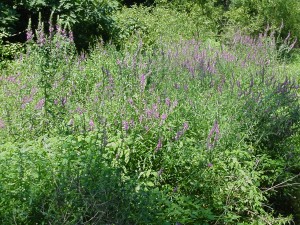


In addition to our current research on invasive plants, which is focused on Alliaria petiolata (garlic mustard) and Microstegium vimineum (Japanese stilt-grass) in suburban forests (see the Deer x Invasives2 web page here), I also have investigated the ecology of several other non-native, invasive plants.
One is the grass Andropogon virgincus (broomsedge), which is native to eastern North America, but introduced in the Pacific basin and invasive in Hawaii (see my Plant-Pathogen Interactions web page here; broomsedge also has an interesting smut fungus parasite).
We also have studied Acer platanoides (Norway maple), which can form dense stands in forests that are typically near landscape plantings of this tree, and the wetland invader Lythrum salicaria (purple loosestrife).

Publications and conference presentations
(All co-authors were TCNJ undergraduate students)
Morrison, J.A. and K. Mauck. 2006. Comparison of native Acer saccharum and non-native Acer platanoides seedling biology. PDF
Dunn, B. and J.A. Morrison. 2005. Competition and natural enemies in the forest floor plant community.
We investigated the complex interactions of native and non-native plant species in the presence and absence of interspecific competition and herbivores. Two non-native invasive herbs, Japanese stilt grass (Microstegium vimineum-MV) and garlic mustard (Alliaria petiolata-GM) and a native tree species, sugar maple (Acer saccharum-SM) were grown in combinations of a single focal individual with or without two heterospecific competitors, in three forests. Half of these were then provided with cages to eliminate large herbivores. Percent herbivory data were collected from focal plants every two weeks for a total of four censuses for each focal plant. At the end of the experiment, we collected the roots and shoots of focal plants to determine dry biomass, root to shoot ratios, and mortality. The end-season mortality showed that while a significant difference in mortality rates was present among the three species, the native sugar maple fell in between the rates of the two non-natives. This adds insight to both the enemy release hypothesis and the environmental resistance hypothesis for biological invasions. Furthermore, the data showed a lack of a two-way interaction between species and competition on herbivory, meaning that herbivory rates were constant with regard to what the focal species was. Competition treatments did, however, show a general trend in the increase of herbivory rates in all three species, calling into question the enemy release hypothesis.
Morrison, J.A. 2001. Wetland vegetation before and after purple loosestrife removal.
Camera, N. and J.A. Morrison. 1999. Seedlings of invasive Norway maple (Acer platanoides) and native trees: vulnerability and canopy influence.
